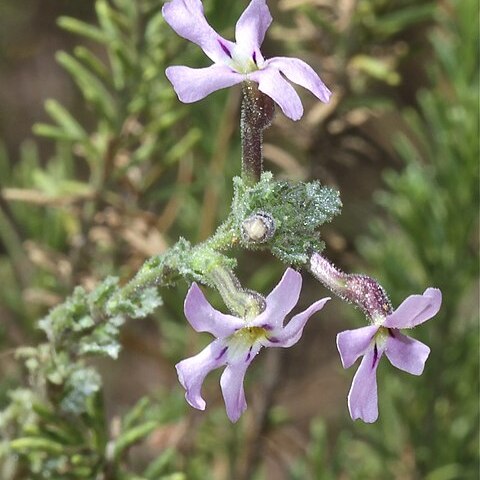Dwarf shrublet, stock stout, woody, up to c. 30 mm in diam., stems up to at least 350 mm long, erect or decumbent, well branched, either thickly clad in glistening glands or with varying degrees of development of glandular hairs up to c. 0.5 mm long, these sometimes predominating (see comments below), leafy. Leaves opposite becoming alternate on the inflorescence axes, pseudofasciculate, largest 10-30 x 5-17 mm, ovate, elliptic or oblong in outline with a broad petiolar part, blade divided to midrib, lobes elliptic or cuneate in outline, deeply cut, segments acute, subacute or obtuse, both surfaces clad in glistening glands, often with the addition of glandular hairs c. 0.1-0.6 mm long, their presence very variable in density. Flowers many, solitary in the axils of the upper leaves forming long crowded racemes. Pedicels up to 2-4 mm long (to c. 8 mm in some hybrids). Calyx tube (0.15-)0.3-0.5 mm long, lobes 2.3-4.5 x 0.3-2 mm at tips, spathulate, the tip broad and 2-5-toothed in the typical plant, narrowly spathulate to oblong in some specimens (possibly of hybrid origin), the lobes entire or with varying degrees of toothing, either glistening glands predominating or various degrees of development of glandular hairs up to 0.2-0.7 mm long, then glistening glands sometimes few. Corolla tube 8-11.5 x 1.5-2 mm in throat, cylindric, abruptly expanded near apex, mouth laterally compressed, limb oblique, bilabiate, c. 6.5-11 mm across the lateral lobes, posticous lobes 1.8-6 x 1.2-3.2 mm, anticous lobe 2.2-5.5 x 1.5-4.5 mm, all oblong, retuse, glandular-pubescent outside, hairs up to 0.25-0.6 mm long, glistening glands as well, broad transverse band of clavate hairs in throat extending briefly onto base of lower lip, lobes varying in colour from creamy white or yellowish to lilac-pink and shades of mauve, throat whitish to pale yellow often with dark purple radiating lines at base of lobes, tube often purplish outside. Stamens: posticous filaments 1-1.3 mm long, anthers 0.7-1.1 mm long, anticous filaments 0.3-1 mm long, anthers 0.4-0.8 mm long, all filaments minutely glandular at apex. Stigma 0.2-0.3 mm. Style 5.5-7 mmlong. Ovary 1.5-2 x 0.7-1 mm. Capsules 3.5-5 x 2-2.5 mm, glistening glands all over. Seeds 0.5-0.9 x 0.25-0.6 mm, sometimes as few as 6 in each loculus. Flowering principally between November and April.
More
Dwarf shrub, up to 0.35 m high. Stems erect or decumbent and well branched with glistening glands or glandular hairs, grey appearance. Leaves pseudofasciculate; blade ovate, elliptic or oblong with a broad petiolar part, margins divided to midrib, lobes elliptic or cuneate; surface with glandular hairs up to 3 mm long, glistening glands on both surfaces. Flowers: many, solitary in axils of upper leaves forming long, crowded racemes; calyx lobes spathulate, apices 2-5-toothed; corolla tube up to 12 mm long, purplish outside; limb oblique, bilabiate, up to 11 mm in diameter, lobes thin-textured, apices truncate or rounded, from creamy white or yellowish to lilac-pink and shades of mauve, throat white to pale yellow often with dark purple radiating lines at base of lobes. May hybridise with J. stricta, J. jurassica and J. breviflora.
Dwarf shrub, up to 350 mm long, either with crowded glistening glands or with a varying amount of glandular hairs. Leaves pseudofasciculate, ovate, elliptic or oblong, petiolate, blade divided to midrib, lobes elliptic or cuneate, deeply cut. Flowers many, single, axillary, forming long, dense racemes in upper parts. Pedicels up to 4 mm long. Calyx: tube up to 0.5 mm long; lobes ± spathulate, 2-5-dentate but can be oblong and entire or variously toothed. Corolla: tube up to 11.5 mm long; limb oblique; lobes oblong, retuse, light cream-coloured or yellowish to lilac-pink and mauve, throat white to pale yellow, dark purple lines at base of lobes.

